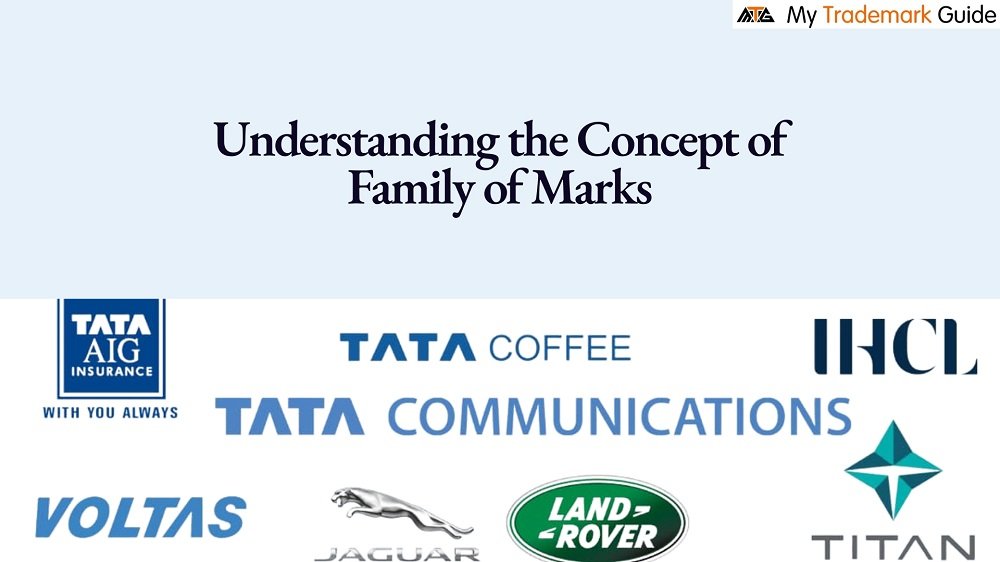Understanding the Concept of 'Family of Marks' under the Trade Marks Act, 1999 in India
Introduction
In the field of intellectual property, trademarks are essential tools for establishing brand identity and fostering consumer confidence. While most discussions focus on individual trademarks, there exists an advanced branding strategy known as the “Family of Marks”. Though not explicitly defined under Indian trademark law, the concept is recognized in jurisprudence and forms an integral part of brand protection strategies.
What is a Family of Marks?
A Family of Marks is a set of trademarks owned by one entity that all contain a common, recognizable element and are used across similar or related goods or services. This common feature could be a prefix, suffix, or a unique combination of words that consumers associate with a single source.
Such marks, when used consistently and extensively, develop a strong association in the minds of consumers, who begin to identify the entire family with a specific brand or origin.

Recognition under Indian Trademark Law
While the Trade Marks Act, 1999 does not expressly define or regulate the concept of a “family of marks”, Indian courts have acknowledged and applied the doctrine in various decisions, especially in opposition or infringement cases where likelihood of confusion or dilution is a concern.
The legal basis for protection stems from:
- Section 11(1): Relative grounds for refusal due to likelihood of confusion with an earlier mark.
- Section 29: Infringement of a registered mark, especially in the context of reputation and similarity.
- Common law remedy of passing off: Protects unregistered marks with goodwill.
Essential Characteristics of a Family of Marks
To establish a family of marks, the following elements are typically required:
- Common and Recognizable Feature: All marks share a visually or phonetically similar component (e.g., “MC” in McDonald’s).
- Ownership by a Single Entity: All marks must belong to the same proprietor.
- Use on Related Goods or Services: Marks should be used on goods or services that are similar or connected.
- Evidence of Extensive Use and Reputation: The family must be known to consumers as such.
Examples of Family of Marks in Practice
✅ Example 1: McDonald’s
McDonald’s is one of the most cited examples globally. The prefix “Mc” is used across multiple marks such as:
- McChicken
- McVeggie
- McAloo Tikki
- McCafe
Consumers associate the “Mc” prefix with McDonald’s, giving rise to a protectable family of marks.
✅ Example 2: Tata Group
In India, Tata Group has created a family of marks using the prefix “Tata”, such as:
- Tata Motors
- Tata Steel
- Tata Tea
- Tata Power
The consistent use of “Tata” across diverse sectors builds a family of marks recognizable by the Indian consumer.
Key Indian Case Laws on Family of Marks
🔹 McDonald’s Corporation v. Sterling Resorts (2001)
Court: Madras High Court
Facts: McDonald’s opposed the use of the mark “McSterling” by the defendant for restaurants and hospitality services.
Held: The court recognized McDonald’s family of marks prefixed with “Mc” and held that “McSterling” was likely to cause confusion and dilution. The court granted an injunction in favor of McDonald’s.
🔹 Procter & Gamble Company v. Joy Creators (2012)
Court: Delhi High Court
Facts: P&G, the owner of marks like “Whisper Ultra”, “Whisper Choice”, sued a competitor for using a deceptively similar mark for sanitary napkins.
Held: The court observed that the plaintiff’s use of the “Whisper” prefix across multiple products created a family of marks and the defendant’s use created likelihood of association.
🔹 Godrej Sara Lee Ltd. v. Reckitt Benckiser (India) Ltd. (2006)
Court: Bombay High Court
Facts: Godrej objected to the use of “Jet” by Reckitt, asserting rights in their “Jet” family of mosquito repellent products like Jet Mat, Jet Coil, Jet Spray.
Held: The court acknowledged that “Jet” had acquired distinctiveness through a family of marks and ruled in favor of the plaintiff.
Legal Remedies Available to Owners of a Family of Marks
Owners of a family of marks in India can seek the following remedies:
- Injunction Against Infringement
If another party uses a similar prefix or suffix causing confusion, the court may issue a permanent or interim injunction under Section 29 of the Trade Marks Act.
- Opposition to Trademark Application
Owners can file a Form TM-O under Section 11, opposing registration of a conflicting mark that may dilute or infringe their family of marks.
- Passing Off Action
Even if not all family marks are registered, the proprietor can invoke common law rights and initiate passing off proceedings based on reputation and goodwill.
- Damages and Accounts of Profits
Under infringement or passing off claims, courts may award damages or direct the infringing party to account for profits earned through unlawful use.
- Rectification and Removal
A registered but deceptively similar mark can be removed from the register via rectification under Section 57 by filing Form TM-O.
Importance of Family of Marks in Brand Strategy
Developing and protecting a family of marks offers several strategic advantages:
- Builds brand consistency and consumer loyalty.
- Provides a wider scope of protection against infringements and cybersquatting.
- Helps in faster recognition and market penetration for new products.
Best Practices to Protect a Family of Marks
- Register each mark in the family individually.
- Use the marks consistently across platforms.
- Maintain evidence of use, advertisements, consumer recognition.
- Monitor the trademark register and marketplaces for similar marks.
Conclusion
The concept of a Family of Marks, though not codified in Indian law, has found strong judicial backing and practical significance in protecting brand identity. As Indian businesses grow and diversify, leveraging and safeguarding a family of marks can be a powerful tool in brand management. Trademark owners must remain vigilant and proactive in enforcing their rights to ensure that the distinctiveness and goodwill of their mark family remain uncompromised.




